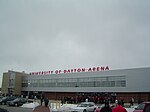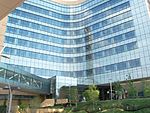Carillon Historical Park
1942 establishments in Ohio7½ in gauge railways in the United StatesAerospace museums in OhioBell towers in the United StatesBuildings and structures on the National Register of Historic Places in Ohio ... and 15 more
CarillonsDayton Aviation Heritage National Historical ParkHistoric house museums in OhioHistory museums in OhioHistory of Dayton, OhioHouses in Montgomery County, OhioMuseums in Dayton, OhioNational Register of Historic Places in Montgomery County, OhioParks in OhioProtected areas of Montgomery County, OhioTechnology museums in OhioTowers completed in 1942Transportation museums in OhioUse mdy dates from August 2023Wright brothers

Carillon Historical Park is a 65-acre (26.3 ha) park and museum in Dayton, Ohio, which contains historic buildings and exhibits concerning the history of technology and the history of Dayton and its residents from 1796 to the present. As a part of the University of Dayton, the historical elements of the park were the brainchild of Colonel Edward Deeds. The major sections include settlement, transportation, invention, and industry. The park also contains the Carillon Park Railroad, a 7+1⁄2 in (190.5 mm) gauge miniature railway. In 2005, Carillon Historical Park merged with the Montgomery County Historical Society to form Dayton History.
Excerpt from the Wikipedia article Carillon Historical Park (License: CC BY-SA 3.0, Authors, Images).Carillon Historical Park
Carillon Boulevard, Dayton
Geographical coordinates (GPS) Address Nearby Places Show on map
Geographical coordinates (GPS)
| Latitude | Longitude |
|---|---|
| N 39.730833333333 ° | E -84.1975 ° |
Address
Deeds Carillon
Carillon Boulevard
45409 Dayton
Ohio, United States
Open on Google Maps





